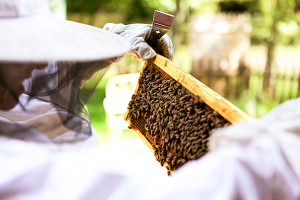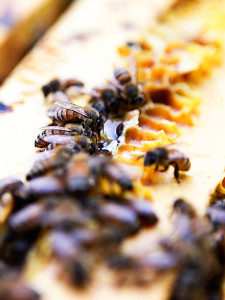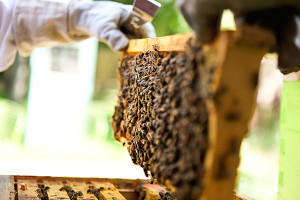It’s March already and spring-like forecasts are just about here! For seasoned beekeepers, that means we should be out checking for signs of life in our hives and planning any necessary replacement orders. For new beekeepers, the time to order is probably yesterday – but there are still plenty of places to order from if needed.
Here’s What I Know About Buying Bees
First, you can buy them locally if you connect with people and ask around. Sometimes we order too many and need to sell a package. Sometimes we produce nucs to sell and they have actually survived the winter and makes them stronger survivor stock. So, checking out the club’s website offerings is a great starting point and a great way to connect locally.
If you do plan to purchase from a business, the bees are typically sold in 2 or 3 pound packages with a queen. The queen can be marked or unmarked. The marking on the queen is located on her thorax (the body part next to her head). The colors of marked queens are done by the year and it is an awesome system for keeping track of the age of your queen.
Here’s the scoop on the years and colors:
- Years ending in 1 or 6 are WHITE.
- Years ending in 2 or 7 are YELLOW.
- Years ending in 3 or 8 are RED.
- Years ending in 4 or 9 are GREEN.
- Years ending in 5 or 0 are BLUE.
What’s exciting to me about this is that I have now had every color of queen in my apiary except blue – so I know I’m excited to get my blue marked queens this year and celebrate my experience. It’s sort of a badge of knowledge to say “I remember my yellow queen in the third hive” or “That red queen was awesome…”
When you order a package of bees, they will be packaged in a wood and screen-covered cage, or possibly a plastic cage that looks like a hair curler.
Here’s a tip: Don’t hand the package to your young child and have him carry it because he will lean it against his chest and a bee will accidentally stick his stinger into young child’s skin and it will take a minute or two for young child to trust you and bees again. – Just trust me on this one.
You can order from someone nearby who’s traveling south or west to pick up bees for lots of people via vehicle. This is a great option if you are like me and worry about them in the postal process.
You can order from a large company and have them shipped through the mail. That’s right! The US Post Office will take your buzzing screened box and bring them to you. If you go this route, I highly recommend calling the early morning post office employees and giving them your telephone number so they can call you upon arrival and not leave the ladies in the sun or rain on your doorstep.
You can order three-banded Italians. You can order Russians. You can order Carniolans. You can order what’s known as Small Cell Bees. I have tried all except the Russians. Here are my observations:
- Italians – I am pretty much sticking with them whenever I order now. They are a pretty sunflower yellow color. They have always been very friendly with me. And they seem extremely focused on honey production. I have had the best luck with the Italians surviving in my apiary. I know everyone has different experiences but with my setup, these have done the best.
- Carniolans – I did try these. They were extremely kind and gentle and happy. They are a darker color and easy to tell apart from the Italians. I really liked them when I had them but they did not seem as productive and did not last long for me.
- Russians – I have not tried these though I hear they do survive winter better than the rest. I also have heard they can be a bit more aggressive and this is the reason I have not tried them. I have children around my colonies frequently and so try to keep everything as docile as possible.
- Small Cell Bees – Ok. So, I LOVED mine. The theory behind the small cell bees is that they are sort of the “mutt” bees. They are what happens to a colony after a few years of not providing foundation and letting the bees build their own freestyle comb. The bees become a smaller size and build smaller cells and this is the size bees are by natural occurrence. Some small cell keepers feel they are more disease resistant and yet others feel they are a version of Africanized. When I had them, they were the happiest most zen-like bees I had. They floated around in a state of bliss. Everyone loved them. However, they did not create much honey. Probably mine were just too laid back. I would buy them again, except I had to mail order them and bees traveling through the mail causes me great anxiety until I have them safely in my hives.
My experience with ordering through the mail was, as I said, a path of great anxiety. I ordered them. They were shipped. Days went by. I checked tracking and nothing showed up online. I made panicked phone calls to post office people. I made wishes. I worried. They arrived seven days later. I don’t know why but suspect there was a worker along the way who was terrified to touch the box (you can totally see the bees and touch them through the screen). About half were dead in the cage. Luckily the queen was fine and they were able to build back up fast. But, for me, I cannot handle the stress of mail ordering.
So, I find a local-ish place making a big trip with a truck to get large quantities and this is how I order.
If you need bees, order soon. I hope I have helped and do want to re-state the above info is mostly my own opinion which has grown from loads of playing around with different options. On your beekeeping journey, you will find your own ways and they will become your own truths.
Happy bee shopping and Hello Spring!
-Kelly Vander Kley




Great article for beginners, thanks
You are very welcome Mel. I love helping people who are on the new side. I’m still learning myself.